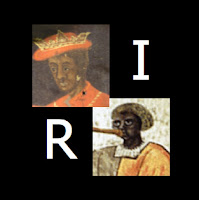The Adoration of the Magi, England,
1450-1500
Alabaster with paint and gilding
Victoria and Albert Museum no. A.39-1946
Of the several potential candidates from
the V&A collection for my essay on the black Magus, back in 2008, this one never even made the short list a number
of reasons.
It was certainly in the running as it within
the course time line c.1420-1520, the piece finally I picked only just made it at c1520. But
vitally this Black Magus wore no earring, which at the time I was first considering works to
write about the earring was an essential attribute for the piece to make it to my short list. The second was he didn’t
look black, his features were far too European.
Detail - The Black Magus
The Adoration of the Magi, England, 1450-1500
Lastly, I just didn’t like the piece, it lacked
aesthetic appeal to me. And to spend four months studying and 4,500 words writing on something I didn't like was not a consideration. Now with the hindsight of five years of study of the
Black Magus I’m going back to V&A to look at this piece again.
I’m booking an appointment to see it, hopefully sometime in October so, I can report my findings as 'breaking news' as part of Image & Reality Black Africans in Renaissance England 2013 my contribution along with Dr Miranda Kaufmann for Black History Month 2013!





